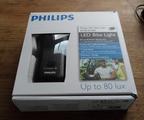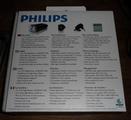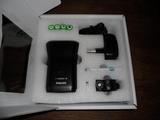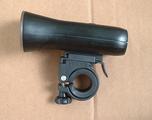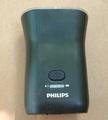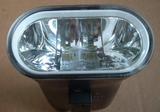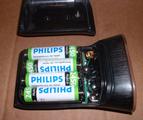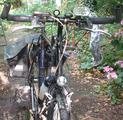Philips LED bike light (LBL), battery powered, with cutoff
The first lamp I tested was lent to me by Charles Tsai/Intelligent design cycles. I've tried it out from 1 August to ca. 20 August 2010. I have bought one two for myself for reference and to modify for use with dynamo which should be interesting... See the dynamo mods here.
On 27-9-2013 I bought another sample to test the ballhead (which I had doubts about the first time I saw at and I read that there is an exchange action so those wanting the old mount can get that) but mainly to test the light colour as I got an email that the colour seems more towards neutral white. And it does.
Contents
This page is so long that I made a contents table for it ;-) The length of this page is caused by the quality of the light beam which made me make a very long description of it and loads of pictures...
Introduction
This lamp is battery powered, and has a cutoff. My preference is for dynamo powered lamps (as you always have a full battery then ;-)), but this is an interesting one and gives a view of what's possible, and yes, that's also possible with a dynamo! (But StVZO is a problem, see the stvzo page)
Beam patterns:
Beam patterns of the light on the floor (well, a piece of wood) and the wall:
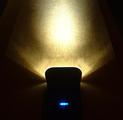
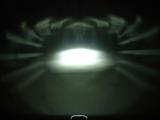
The artefacts that you can see on the wall are also noticeable when you ride, e.g. when riding along a hedge, but they are not annoying or distracting.
Here's an example, look closely to see the artefacts on the hedge on the left:
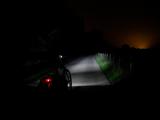
Beam shots
Note that the original beamshots on this page (from August 2010) were made with a tripod that's really too small. The maximum height of the camera (measured at the centre of the lens) mounted on that tripod is about 1.15 m. For the rules I now use to make beamshots see Camera settings, camera height/position, lamp height, roads used, and markers for beamshots. These rules formalise what should be done to make proper beamshots, but the essential change is mounting the camera higher which gives a view more like that which you would have sitting on a bicycle fitted with such a lamp.
New pictures with higher tripod can be found on the page with all beamshots and on the Betty review page.
Low and high beam on road 1
Road 1 is ca. 3.55 m wide, not completely flat, so doesn't show the beam shape particularly well. Details on road 1.
[ Lamp height: ca. 1.05 m, camera height: ca. 1.15 m, F3.5, ISO 80, 3s with a Samsung ST70, N.B.: 14 megapixel images ]:


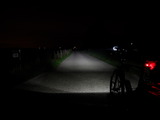
Low and high beam on road 2 (rough asphalt)
Road 2 is ca. 5.00 m wide, and the centre of each white stripe is 3.80 metre apart from the centre of the next one. Road is curved from left-right and possibly a little length wise. Details on road 2.
[ Lamp height: ca. 1.05 m, camera height: ca. 1.15 m, F3.5, ISO 80, 4s, camera: Samsung ST70 (N.B.: 14 megapixel images), retro-reflective markers at 25m, 50m, 75m ]:

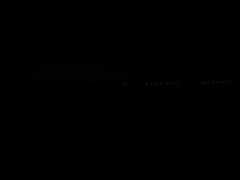
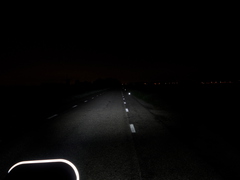
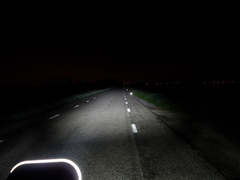
Until I've made pictures with my new tripod (with camera at ca. 1.80 m), here's a picture taken with the camera in my hand at about 1.80 m high, so a bit shaky. This resembles more what you will see while cycling and it shows better that the beam lights up everything up to almost the 3rd marker at 75 m (ca. 2 M pixel image):
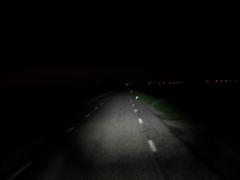
Low and high beam on road 3 (reddish asphalt)
Road 3 is ca. 2.55 m wide, pictures from position 1. Note that this road is not completely flat, so from these images you can't get an impression of how far the beam gets on flat roads, you need the images of roads 2 and 4 for that. Details on road 3.
[ Lamp height: ca. 1.05 m, camera height: ca. 1.15 m, F3.5, ISO 80, 4s with a Samsung ST70, (N.B.: 14 megapixel images) ]:

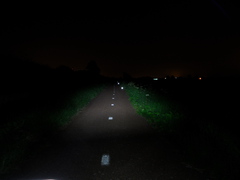
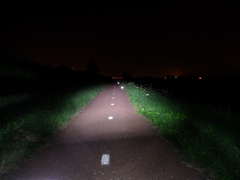
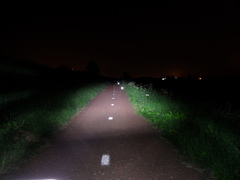
Low and high beam on road 4 (smooth dark asphalt)
Road 4 is ca. 3.85 m wide, and the centre of each white stripe is 3.80 metre apart from the centre of the next one. Details on road 4.
[ Lamp height: ca. 1.05 m, camera height: ca. 1.15 m, F3.5, ISO 80, 3s, camera: Samsung ST70, (N.B.: 14 megapixel images), retroreflecting objects were placed at about 35m and 70 m ]:

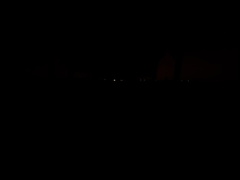
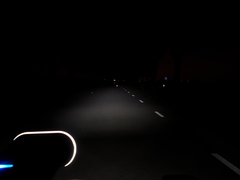
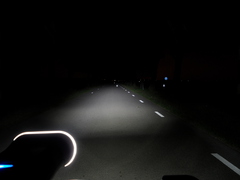
Oncoming shots
Oncoming shots at 50 m and 20 m distance:
(also made with a new Samsung ST70 camera, so not comparable to the shots of the Magicshine and Edelux which were made with an old Fujifilm 2600z)
[ Lamp height: ca. 1.05 m, camera height: ca. 1.15 m, F3.5, ISO 80, 3s with a Samsung ST70, (N.B.: 14 megapixel images)]:
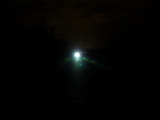
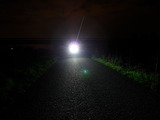
Video of the Philips LED bike light in action
Here's a short film on youtube ('flash' alert) that is probably a better indicator of how the Philips LBL performs than the clips I tried to make with the Samsung ST70 camera: http://www.youtube.com/watch?v=lej8pbR5RDQ. I asked the maker and he says he made it with a Nokia N82 phone... It's an amazingly good result and much better than what I got with the ST70. (The N82 appears to be well known for its large sensor size and good quality video).
Om the video page I put a film made with a Samsung EX1, comparing the Philips SLD and Philips LBL. This shows the difference between the best dynamo headlamps and the LBL quite well.
Experiences:
The lens lets light go upwards, directly to your eyes which is bad, so you really need to put some black tape on that so you can see better in the dark (this is a serious design flaw!). The blue LEDs that indicate the remaining energy in the batteries should be less bright, they attract too much attention when riding.
Pressing the button makes the lamp come on in low mode, pressing it again after that switches between low and high mode. Keeping the button pressed for just over a second switches the lamp off.
My first impression on 1 August: Wow, that looks to be nearly a car headlamp! Best bike lamp (for on the road) that I've ever seen, it blows the Magicshine and Ktronik lamps away...
The beam starts off very bright, then it gets a bit darker, then again brighter where the main section of the beam begins. This main section is very wide from the start, it lights up a path about 7 metre wide. Much more than an Edelux which has a beam starting at about 3.5 m wide, which gradually gets wider. This wide beam is good for in the rain on wet smooth asphalt, as in that case you're to a large part dependent on reflections from objects beside the road to orient yourself. As the beam is 7 metre wide, it's wider than most roads so you will get to see the green or trees etc. on the side of the road, whereas with the Edelux you'll only see a little on one side of the road as its beam is not wide enough on most roads (even though you're cycling on one side of the road, and not in the middle).
I get the feeling it puts out more light than 270 lumen, as it gives so much more light than the Edelux.
Updates for measurements of light output in integrating spheres: 21 October 2010: Olaf Schultz (www.enhydralutris.de) measured 291 lumen +/- 5%, 5 November 2010: The lamp that I tested and used in my beamshot pictures has been measured in the labs of well known flashlights which gave a result of 270 lumen, 19 November 2011: Another LBL was measured (by O.Schultz?) for the German magazine RADtouren, outcome was 282 lm, 10 Dec. 2011: Yet another LBL was measured at 265 lumen in France. So it's quite clear that Philips has from the start been quite accurate about the light ouput of the LBL and was one of the first manufacturers to advertise with real (measured) values...
Compared to the Edelux the beam is noticeably wider (ca. 7 metre at 15 metre distance from the bike, where the Edelux's beam is about 4 metre wide), longer and perhaps a bit brighter. This feeling of producing so much more light could just be apparent, due to the slightly greenish LED colour used in the Edelux (there is a bit of an advantage in cotrast for this greenish colour, although my tests show that neutral white is much better, and if you have as much light as the LBL then this contrast is a non-issue), just like a cool white light appears brighter than a neutral one of the same output. I think however that the wider/longer beam is what gives the impression of 'much more' light.
I and the guy I have the Philips LBL on loan from, rode with various lamps comparing the Edelux, Kerry's triple XP-G (dynamo powered, see below), the Philips LBL and an old halogen headlamp. We both felt that the Philips gave an extremely good illumination and we both had the idea that more light was not needed, in fact, switching back to low mode was easier on the eyes sometimes, for example due to little posts on the side of the road with reflectors (poles on the left hand side of the road have a white reflector, poles on the right hand side a red reflector). With the LBL on high they reflect so much it's almost annoying... I'll do more comparison tests at a later date and make some pictures of these poles.
Philips' claim of a throw of 80 metre looks reasonable: I'd say, ca. 70 m from my first test (in later tests I came to the same distance). With the Edelux I get ca. 45 m and the Ktronik triple XP-G ca. 40 m.
Light above the cutoff: The standard route I take a lamp on to check for usability, has all the essentials: Completely dark sections, other sections with ok street lamps, going through a small village, and some time later a few km in a larger city. This is a 10 km ride, and the first ride with the Philips LBL on which I looked to the furthest retro-reflecting object, I got a reflecting traffic cone at a distance of 630 metre. With the Edelux after lots of rides I got to about 450 metre. I think it's very hard to improve on this (almost impossible) as that road just isn't straight enough for the objects to be spotter earlier... Now, at first this was impressive but when thinking more about it later, this really means the Philips LBL puts out more light above the cutoff than the Edelux, and this was actually confirmed with the oncoming test I did later. So, I changed my mind about this and this is not a good thing per se. I would like to see less light above the cutoff... (Addition June 2011: See also my StVZO analysis page that shows that StVZO is not strict enough and too bright light above the horizon is possible with StVZO approved headlamps).
Every time I compare it with other lamps, the Philips LBL stands above them by a long way. It's astonishing to see how much light it gives on unlit roads, and astonishing in how much better it is than a Magicshine and Triple XP-G.
After making the beamshot pictures of the LBL, and having compared them to lots of beamshots of various lamps on the IBC forum (www.mtb-news.de, see http://www.mtb-news.de/forum/showthread.php?t=302353: Nightshots, Nightpics, Ausleuchtungsbilder hier posten, only! ) I think the Philips LED bike light is at least as good as any symmetric beam lamp that produces 1000 lumen (real lumen, not marketing lumen), for use on the road. So I don't think for example a Lupine Betty (old version, measured at ca. 1000 lumen) is better than this lamp in case of on-road use. Not that the Lupine Betty should be used on regular roads, because it shouldn't! Update: I've compared the LBL with the 2011 Betty which produces ca. 1850 lm, which puts more light on the road than the LBL, but there's not a dramatic difference. Throw is also almost the same. A problem that becomes more apparent as lamps become more powerful is that the near field is always too bright with symmetric beam lamps. This is another reason why the Betty 2011 hardly illuminates the road better than the LBL, which isn't too apparent from the camera pictures but in real life the Betty doesn't doesn't appear to be better than the LBL. This is because the eye adjust to the brightest light it encounters...
2011-11-26 Hmm, I just noticed some newer packaging of the LBL says '1000+ equivalent lumens'. See here. I should get paid by Philips for thinking up their advertisement material! ;-)
On one of my beamshot sessions on road 2, a truck at about 1 km distance dimmed its lamps (high beam off) in response to seeing the Philips LBL. This was at 3 o'clock in the morning when I was making my last beamshot. The closer he got to me the slower he was going. When he went past me, he was going at about walking pace... I don't know what he thought about the lamp, but it was pretty amusing.
What oncoming traffic sees: Again using an Edelux I rode towards the Philips LED bike light. It was properly adjusted so the cutoff was below the horizon, and I never got blinded, the road was always clearly visible. This was so both in low and high mode. I then adjusted the Philips LBL so that the cutoff was pointing a little above the horizon, and when I got fairly close it was pretty annoying but I didn't get blinded. I wanted to do some more tests with various degrees of setting 'above the horizon' but I haven't got round to that yet.
On a dark road with no street lamps I encountered a group of cyclists (going home from a bar or whatever) on a Saturday/Sunday night at 3 o'clock: I put the Philips LBL on high to see what would happen, and one said "wow, nice lamp". Another group came a bit after that. I had put the Philips LBL on low, and one guy complained about the strong light, another said it was ok on low, but "more light would be annoying". I tested a bit more what cyclists with poor lighting would see when encountering someone with the Philips LBL, by cycling with the Edelux on standlight (which is only a little better than an old halogen light beam) towards the Philips LBL on high. I could not see my own beam, but I could see the road because of the light from the Philips LBL. Then when I passed it, there was a short time (less than a second) during which I could see very little but almost immediately I could see the road again with the light from the Edelux's standlight. So, it's not all that bad, but pretty intense and I think a lower mounted lamp (at ca. fork crown height) would be better. I have tested it: There's not much difference, but mounting the lamp lower gives a slightly lesser illumination of the road surface...
The batteries, driver
The LEDs in the LBL in high mode are driven at 0.689A according to Olaf Schultz' measurements (www.enhydralutris.de) and I have done some measurements with the limited equipment I have, which correspond very well. From runtime calculations I would estimate current through the LEDs to be about 0.80A, but when measuring I found the voltage drop over a small resistor of 0.05Ω to be 35.3mV which gives a current of 0.706 A (measurement error at worst 5% due to the resistor but as I averaged resistors I think it's much better, I might do a more accurate test). So the driver in the LBL is not that efficient, but also, there is room for a lot more light output when running the LEDs at 1.0A (maximum the Rebels are rated for).
This lamp comes with a charger with USB plug. The lamp's batteries can be charged using that charger or from a PC via USB cable. You can of course also take out the batteries and charge them separately in a charger, but that's a bit more hassle as you need to take off the bottom cover with a small inner-hex key then. With the lamp I bought as a reference/modification lamp, I tried what I'd heard before: Charging the lamp while it's on. This doesn't work, the lamp switches off when it's being charged.
For those interested in buying such a lamp (I'm really only interested in dynamo lamps, this test for me is to get a view of what's possible, and what the problem areas are in bicycle lamps) the following might be useful:
I did a refresh-and-analyze on the Maha 9000 charger using a charge current of 1 A and discharge current also 1 A: The batteries (labelled 'Philips' and '2450 mAh') were shown to have a capacity of 2225 to 2265 mAh (whatever that means, as the voltage drops when discharging, so what's the average voltage and thus the energy in the batteries? Or is that taken into account by taking 1.2 V as standard and higher voltage means more mAh? The manual doesn't answer any of these thoughts).
I then put the Philips LBL on high, in a room that was at about 23 °C.
Philips LED bike light: Battery/run time test
| Time (h:m:s) |
What happens? |
|
| 0:00:00 |
Lamp switched on on high, 3 blue LEDs are on. |
|
| 0:31:00 (approx) |
2 blue LEDs are on. |
Approximate time, lamp is lukewarm |
| 1:11:00 (approx) (ca. +40 minutes) |
1 blue LED is left on. |
Approximate time |
| 1:50:20 (ca. +40 minutes) |
All blue LEDs are off. |
|
| 1:59:18 (ca. +9 minutes) |
Lamp switches off. |
|
The instructions of the lamp currently (that is, with the LED bike light that I bought for reference) state a run time of 2 hours on high after which the lamp switches to low, and according to those instructions it should continue to run on low for 30 minutes at that point. So I asked Philips if the electronics was changed (or if the controller was programmed differently).
Answer from Philips:
Since approx. July we have switched the electronics in such a way, that when end of battery life approaches, the light goes automatically to eco mode, to make sure the cyclist can still get home safely (and is not simply left in the dark).
The run time on high should still be 2 hours. Does this mean the current each LED gets is now lower or is the controller at the same time more efficient now?
Note: Short run times caused by faulty electronics?
1 Nov. 2010 and following: I've had 2 reports of short run time around this time (more later), the first where the lamp runs at high for 1 hour 10 minutes, after which the lamp switches to low mode and it keeps going in low for about 2 hours 45 minutes. This test was done indoors, at ca. 18-22 degrees Celsius. Later tests with fairly low temperatures outside down to ca. 6 degrees gave almost the same run time.
Because there's no change with temperature (NiMH cells usually have lower capacity running in very low temperatures) this is probably due to a defect in this lamp's electronics, and the supplier asked the buyer to send back the lamp...
I have tested run times with the lamp I bought with the supplied batteries at room temperature (20 and 21 November). This lamp also has a short run time at high and my tests seem to show that there is a problem with the run time caused by a timer issue, perhaps more.
I have reported my findings (on 22 November 2010) with the description of the tests I did to Philips. They are currently investigating the problem (whether software/hardware related etc.)
For test results/description and the version of my lamp see: Philips LBL battery test results. You can try this test yourself if you don't get full run time. Note that the batteries may need to be charged/discharged a few times before they get to full capacity, in my case one of the 4 batteries had low capacity until I charged/discharged that 2 times, the others were immediately ok.
When I get the results from Philips, the batch after that should be OK. I don't know if some or all lamps in the current production are affected, but if you want a fault free lamp, please wait with buying until the results from Philips are on my webpage.
In a pdf from Sept.2011 about a meeting for dealers (which I came across in Feb. 2012), it is stated that runtime on high was reduced to 1.5 h for safety after which the lamp switches to low (this pdf also states that the instructions still say 2 h on high). Perhaps this is for the temperature dependence of the capacity of NiMH batteries? In the Q&A section they also tackle the 70 minute runtime problem but the 'solution' to that issue is wrong and misleading.
Short run times caused by cold?
In the cold most regular NiMH batteries have a lower capacity than at room temperature. Eneloops are apparently better. I want to test this but note that other battery types are also sensitive to cold, Li-Ion doesn't last long either when it freezes.
A drastic solution to low run times for those who find the 2 hour run time on high is not enough, could be to use a b2flex or maxflex (http://www.taskled.com) and an external battery pack. The advantage, besides getting a battery pack the size you need, is that you can set the output current to what you want, even running the LEDs at 1A is possible then (note that the LEDs are wired in series). I will make a new webpage about my dynamo modification and about using a taskled driver soon. Beamshots of these modified LBLs will be made of course to compare with a standard LBL.
|
Lamp mounting height: On the main lighting web page I recommend lamps to be mounted on fork crown height. Well, for powerful lamps such as the Philips LBL ca. handlebar height could be better. A lower lamp does give more shadows which gives more information on the road surface. At first when I tried different lamp mounting heights using just a single Edelux mounted at either fork crown height, or handlebar height with special mounting bracket, I didn't think this was much of an issue. When I tried the Magicshine (handlebar mounted) and switched between that lamp and the Edelux while cycling, it was clear that the shadows (of small rocks on the road or because of unevenness in the road itself) are larger and do stand out more when a lamp is mounted lower, and it showed that for a 180 lumen lamp such as the Edelux, fork crown height is better because of the shadows. But as the Philips LBL gives so much more light, I think in this case mounting the lamp higher is better. Shadows are of not much interest as you can just see everything on/from the road due to the large amount of light. There's also an issue of which height a lamp is designed for... See the Main lighting page: Lamp height: Putting a lamp meant for 0.75 m at 1.05 m.
Amount of light on the road: A symmetric beam puts about 0.60 to 0.70 of the light on the road (or rather, below the horizon, see also Main bicyle lighting page: Amount of light on the road from a circular beam), but not all where it's useful and the distribution on the road is not optimal either. As both the Magicshine and Triple XP-G, which produce ca. 500 lumen, are not as good as an Edelux (180 lumen at 30km/h) in both throw and brightness with which the road surface is illuminated, it's clear a symmetric beam lamp needs to be ca. 4 times as bright (at least) as a good beam with cutoff to have the same illumination of the road surface. The Philips LBL has a wider beam so for this I think the factor might be a little lower, but I estimate that the Philips LBL which is claimed to be at least 270 lumen (which I think is real, possibly even conservative, considering how much better it is than the Edelux; Update: This has been confirmed by 2 independent measurements of 2 different samples), will probably be better than any symmetric beam of 800 lumen, but from pictures (beamshots) of 1000 lumen lamps, and my estimates based on how much better the Philips is than the Magicshine and than the Ktronik triple XP-G, I think it's better than even 1000 lumen lamps (real lumen, not marketing lumen). This may depend a bit on the beam pattern of the symmetric beam lamp.
Addition: My tests of the Lupine Betty 2011 (7x XP-G, ca. 1850 lumen) have confirmed once again how effective a good beam with cutoff is. The Betty is a bit better on pictures but in use this difference is not noticeable. This is caused in particular by the overexposure of the near field even when aiming the lamp at the horizon.
Conclusion
Best bike lamp I've ever seen. Almost a car headlamp. Better than any motorcycle headlamp I've seen so far. Much more light than an Edelux, much more light on the road than the Magicshine or Ktronik's dynamo powered triple XP-G.
There's not much more to wish for in a bike lamp for on-road use, except to have it dynamo powered! Well, OK, I would like to see:
- A bit more light close to the bike. As you can see in the first set of beamshot pictures from behind the bike, there's a bright section, then a darker bit, then the main beam. If that darker bit was as bright as the main beam, I'd like it even more.
- Of course there should be no light from the lens going upward, this reduces your night vision (easily fixed with some black tape as I said at the start of the review, but it is a design fault).
- If I may continue with my wishlist: Neutral white LEDs are easier on the eyes, both your own, and those of people you will encounter. Btw., in the LBL the LEDs are what Philips calls 'crystal white' which is about 5500K, which is cool white. Neutral white is ca. 3700K-5000K. I think somewhere in the region of 4000-4500 K is optimal. 2010-10-19: The tests I did with LED light colour were after the initial review of the LBL, and they clearly showed that neutral white is superior to cool white under all circumstances.
Conclusion for the current version with faulty/changed electronics
I consider this lamp to be great for modification. Take another LED driver such as the b2flex or maxflex from taskled and an external battery, and you can set the current through the LEDs as you wish and determine runtime as you wish with the choice of capacity of the external battery you choose.
See Philips LBL: Modification
Artefacts and glare for oncoming traffic (2011-12-9)
In my original oncoming test of the LBL I found the annoyance quite high for a lamp with StVZO compliant cutoff. I thought it was perhaps due to setting the angle such that the lamp shines to 70m, but end of 2011 when I finally resumed serious testing of headlamps, which I couldn't do from Jan. until recently, I compared it against the Saferide 40 which is much more pleasant than the LBL. Coupled with that is the information that Philips' e-bike headlamp from 2010 did not pass the tests required for motorised vehicles, and the talk I had with a designer of car headlamp lighting in 2010 who said that a car lamp with a wall pattern as the LBL has, with artefacts above the horizon, would never get approved. Together this makes me now think, and testing I did so far seems to confirm, that the artefacts are to blame for at least a part of that annoyance. A further test in January 2012 confirms that the biggest annoyance is at the position of the artefacts. Philips changed from Rebels to Altilons in the new version of e-bike headlamp, and that version should become available soon, at least for OEMs. I have requested one for testing and it will be interesting to compare it with the LBL and see how much better for oncoming traffic it is. And to see whether the e-bike lamp is as good as the LBL.
A reader mentioned that the LBL can be inserted the wrong way round (so the mounting bracket was mounted the wrong way round). The problem is then that the lamp can come off while riding on a bumpy road as it's not properly locked. I have checked this and he is right. I'm not sure this is much of an issue, but make sure the mount is installed the right way and that the light clicks onto it.
In my section 'News from manufacturers and other sources' I mentioned in September 2012:
News dated 5 Sept., so was this actually introduced on Eurobike? I couldn't be there, again, so I was dependent on reports. It seems not much else of interest was introduced besides the B&M Luxos. The Philips Saferide 80 will come in a version with ball head to angle it any way you want. How will that hold up on bumpy roads?
Another reader wrote to me that he indeed had a problem with the ball head not holding the lamp well enough on bumpy roads for him, despite proper tightening. Well, when I saw the picture the first thing I thought was that the ball should be bigger as the forces can be quite large. For the size of the ball-head, I thought that the lamp sits a bit too high above it, giving a lever which means it might move on bumpy roads. Perhaps not enough testing was done with it? But also I think this is another example of overengineering. I've mostly said it in emails but gave some hints on this site that the Philips designs are all very complicated (Lumiring taillamp, electronics being made tight in the Saferide 60 and Saferide Pedelec headlamps, the Lightring taillamp too I would have designed differently) and complexity gives rise to failures in ways the designers didn't expect. I have some ideas on how to do it quite differently, but that's a story for another day :)
I may test the LBL with this ball head in the future (it's also available loose as a spare part, the old mount seems no longer available as a spare part).
The ballhead is going to be replaced by the original mount, but I got my hands on one mainly to test the light colour, and I will test the ballmount anyway :)
Pictures to come soon.
My verdict on the new version: The ballhead doesn't work well (it's going to be phased out, replaced with the original mount), but as for the rest It's fantastic! Low mode gives me more I can see with, Philips says it's 35 lux though it looks the same intensity, when looking fairly close to me on the road, as the old one, but that could be due to the cooler light of the old model (20 lux low mode) which gives the impression of 'brighter'. Whatever the case may be, I can see farther and better with the low mode and the high mode is just fabulous, especially for non-paved roads. And it's much much easier on the eyes (for myself but also for oncoming traffic).
The electronics is also improved, it's possible to switch back to high mode when the battery is low. You've been warned with the switch to low mode when the battery indicator goes red, and then it's your own choice to get stranded with no light when running on high :)
The status light is like on the saferide 40, a ring of light around the switch, which goes from green (full) -> orange -> red (nearly empty). The status light is not too bright either! (this was a problem with the original model, the blue LEDs there are too bright).
The light colour is a bit cooler than my FEREI torch which I modified with a Cree XP-G 5B1 LED (in the range of ca. 4100K-4250K), so I would estimate light colour temperature at somewhere from 4500K - 5000K. A bit lower would be better, but this is already quite good. Perhaps it was even the first bicycle headlamp to not use cool white, before the 2nd version of the H-one S? I don't understand why Philips doesn't mention this improvement, to me, or in their advertising.
I saw a critical comment on a German forum about the battery indicator, in that when it had been red, when the lamp aws switched off for a little while, it goes back to green when using it again, but this is the problem with NiMH, it's hard to ascertain exactly the power in the batteries. The electronics seems to take voltage and possible voltage drop into account in such a way that the status should show fairly accurately the proper status again relatively quickly, and it allows you to extract just about all the power from the batteries, so it seems the current electronics is about as good as it can be.
One thing I don't like: The battery indicator when charging is reversed. When charging, the indicator goes from orange to red (full). Why not from red to orange to green? One could take the red as a 'stop' sign in both cases, but I would think it's more logical to use the colour as a status, not a signal.
It seems Philips took almost all comments from me and others to heart (except using LiIon batteries, and it still can't be used while charging), and the result is fantastic. It's way better than any other bike headlamp... (for non-MTB use)
Oh, that reminds me, I thought the Pedelec 80 that I used with the special dynamo driver on my trip in Germany, was quite good while I used it in Germany, in seeing leaves etc. I wasn't sure whether the light colour had been lowered compared to an earlier model, I think not much if any, but on the high mode (0.85A though the LEDs the colour of leaves/browns were fairly well distinguishable, perhaps it was just because of the amount of light?). I think this was the replacement lamp I got mid 2012 or thereabouts. But I'm not going to compare it to the new Saferide 80, as I have just removed the entire system from the bike to send to friend for testing. Perhaps I will test a new Saferide 60 to see if they changed to lower temperature LEDs in the dynamo lamps, that would be interesting to know...
2013-12-1: I've tested a newer Saferide 60 and it too has a lower colour temperature now... Excellent!
And something else I noticed long ago already: The first lamp I bought in 2010 seemed to have stainless steel bolts/nuts on the mount, no rust. A later one rusted pretty quickly which I hate! Penny-pinching on this stuff is not cool. I will check whether the bolts rust on the 3D mount, if so I presume it will happen on all mounts these days.
Comparison to other bike lamps?
See: Possible competitors to the Philips LED bike light.
Last modified: Sun Sep 29 16:11:50 CEST 2013
